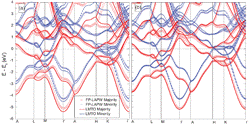Department of Physics and Astronomy: Publications and Other Research
Document Type
Article
Date of this Version
2002
Citation
Journal Of Physics: Condensed Matter, 14 (2002) 565–589; PII: S0953-8984(02)28204-1
Abstract
The earlier-developed master equation approach and kinetic cluster methods are applied to study the kinetics of L10-type orderings in alloys, including the formation of twinned structures characteristic of cubic–tetragonal-type phase transitions. A microscopical model of interatomic deformational interactions is suggested which generalizes a similar model of Khachaturyan for dilute alloys to the physically interesting case of concentrated alloys. The model is used to simulate A1 → L10 transformations after a quench of an alloy from the disordered A1 phase to the single-phase L10 state for a number of alloy models with different chemical interactions, temperatures, concentrations, and tetragonal distortions. We find a number of peculiar features in both transient microstructures and transformation kinetics, many of them agreeing well with experimental data. The simulations also demonstrate the phenomenon of an interaction-dependent alignment of antiphase boundaries in nearly equilibrium twinned bands which seems to be observed in some experiments.



Comments
Copyright 2002 IOP Publishing Ltd. Used by permission.